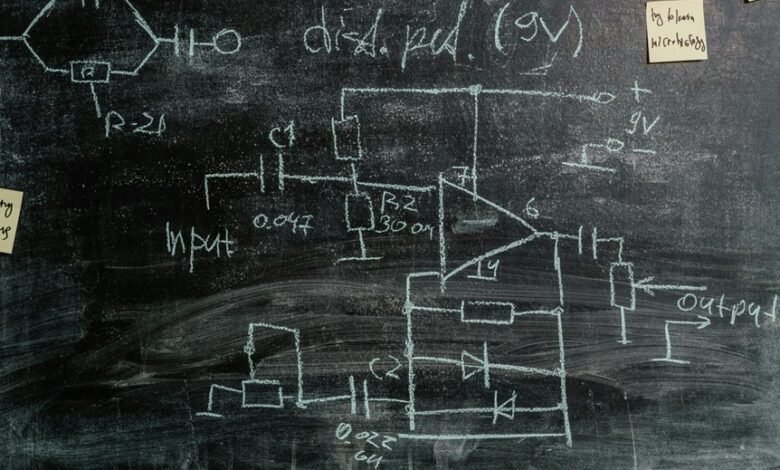Physics Class 12 Notes 2025: Key Concepts to Focus On

As students prepare for the Class 12 Physics curriculum in 2025, it is essential to recognize the fundamental concepts that will shape their understanding. Topics such as motion in one dimension, laws of motion, and energy principles will serve as building blocks for more complex ideas. Exploring these key areas not only enhances comprehension but also sets the stage for advanced studies. What implications do these foundational concepts hold for the future of physics education?
Understanding Motion in One Dimension
Understanding motion in one dimension is essential for grasping the fundamental principles of physics, as it lays the groundwork for more complex concepts.
At its core, the displacement definition quantifies the change in position of an object, while velocity calculations provide insight into speed and direction.
Mastering these elements empowers individuals to explore and appreciate the dynamic nature of the physical world around them, promoting a sense of freedom.
Laws of Motion and Their Applications
The principles of motion extend beyond one-dimensional scenarios, leading to the formulation of the laws of motion that govern the behavior of objects in various contexts.
Newton’s Laws define force interactions within inertial frames and address frictional forces, circular motion, and accelerated motion.
Momentum conservation plays a crucial role, highlighting real-world applications and enabling a deeper understanding of dynamic systems and their complexities.
Work, Energy, and Power: Fundamental Concepts
Work, energy, and power are fundamental concepts in physics that describe how forces interact with objects to produce movement and changes in energy states.
The work energy principles illustrate the relationship between work done and energy transfer, while power calculations quantify the rate at which work is performed.
Understanding these concepts empowers individuals to analyze and appreciate the dynamics of physical systems.
System of Particles and Rotational Motion
In the study of mechanics, the behavior of systems composed of multiple particles and their rotational dynamics plays a significant role in understanding complex physical interactions.
Key concepts include the center of mass, angular momentum, and moment inertia. Torque equations govern rotational dynamics, while equilibrium conditions ensure stability.
Analyzing a rigid body about an axis of rotation enhances comprehension of these fundamental principles in physics.
Gravitation: Laws and Applications
Gravitation serves as a fundamental force shaping the interactions between objects in the universe, governing everything from the motion of celestial bodies to the phenomena experienced on Earth.
The universal law of gravitation describes how masses attract each other with a force proportional to their masses and inversely proportional to the square of the distance between them, influencing gravitational potential and shaping orbits.
Mechanical Properties of Solids and Fluids
Understanding the mechanical properties of solids and fluids is essential for comprehending how materials behave under various forces and conditions.
The stress strain relationship illustrates how solids deform under load, revealing their elasticity and strength.
In fluids, the concept of buoyant force explains why objects float or sink, emphasizing the interplay between density and gravitational forces.
Mastery of these principles is crucial for practical applications.
Thermal Properties and Thermodynamics
While exploring the principles of thermal properties and thermodynamics, one discovers the fundamental concepts that govern heat transfer, temperature changes, and energy transformations in various systems.
Key topics include specific heat, thermal equilibrium, and thermodynamic processes involving ideal gases.
Understanding entropy changes and phase transitions is crucial, as well as mastering calorimetry techniques to measure heat accurately in diverse experiments.
Kinetic Theory of Gases
The Kinetic Theory of Gases provides a comprehensive framework for understanding the behavior of gas molecules in motion. It elucidates pressure relationships, emphasizing how molecular speed varies with temperature effects.
The theory distinguishes between ideal and real gases, revealing deviations in behavior under varying conditions. Such insights empower individuals to grasp the fundamental principles governing gas dynamics, enhancing their appreciation for the natural world around them.
Oscillations and Waves: Key Principles
Oscillations and waves are fundamental phenomena that permeate various aspects of physics, influencing both natural and engineered systems.
Understanding simple harmonic motion reveals oscillation frequency variations, while wave properties like sound waves illustrate resonance phenomena and wave interference.
Damping effects can alter oscillatory behavior, and wave-particle duality offers insights into the nature of waves, enhancing comprehension of these essential concepts in physics.
Electrostatics: Forces and Fields
Electrostatics encompasses the study of electric charges at rest and the forces and fields they generate.
It involves concepts such as electric fields around point charges, the application of Coulomb’s law for force interactions, and the behavior of electric dipoles.
Capacitor systems utilize dielectric materials for storage, while electrostatic shielding protects sensitive components, illustrating the significance of field lines in understanding electric potential.
Current Electricity: Concepts and Circuits
Understanding current electricity is essential for grasping the principles that govern the flow of electric charge in circuits. Key concepts include current flow, the impact of resistance factors, and the role of voltage sources.
Mastery of Ohm’s law facilitates circuit analysis, distinguishing between series circuits and parallel circuits.
Furthermore, power calculations are crucial for determining energy consumption in various electrical applications.
Optics: Light Behavior and Applications
Optics, the branch of physics that examines the behavior of light, plays a crucial role in a wide range of applications, from lenses in eyeglasses to advanced imaging systems.
It encompasses concepts like light interference, light refraction, and polarization effects.
Various lens types facilitate color dispersion, while fiber optics and laser applications utilize total internal reflection, bridging wave-particle duality in innovative optical instruments.
Conclusion
In conclusion, mastering the key concepts outlined for the Class 12 Physics curriculum in 2025 is akin to building a sturdy bridge to advanced studies. Each concept, from motion to gravitation, serves as a vital support beam, ensuring a strong foundation. By delving deeply into these topics, students will not only grasp the principles that govern the physical world but also empower themselves to navigate the complexities of future scientific challenges with confidence and clarity.




